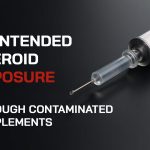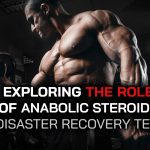Your cart is currently empty!
Category:
Medical Applications of Anabolic Steroids
November 16th, 2024 by anabolicpoint1. Treatment of Hypogonadism
Hypogonadism occurs when the body produces insufficient testosterone, leading to symptoms such as reduced libido, fatigue, muscle loss, and mood disturbances. Anabolic steroids, such as testosterone cypionate and enanthate, are prescribed to supplement or replace testosterone in affected individuals. This therapy improves energy levels, bone density, and overall quality of life.
2. Management of Muscle-Wasting Diseases
Anabolic steroids have proven effective in treating muscle atrophy associated with conditions like HIV/AIDS and cancer. By promoting protein synthesis and nitrogen retention, these steroids help patients maintain muscle mass, strength, and functionality during illness.
3. Chronic Anemia
Certain anabolic steroids, such as oxymetholone, stimulate red blood cell production in the bone marrow. This makes them a viable option for treating chronic anemia caused by conditions like kidney failure or aplastic anemia, where the body’s ability to produce blood cells is impaired.
4. Osteoporosis
In some cases, anabolic steroids are used to treat osteoporosis in men by increasing bone density. Testosterone therapy may help reduce the risk of fractures in older men by enhancing bone strength and mineralization.
5. Delayed Puberty
In adolescent males with delayed puberty, anabolic steroids can be administered to stimulate the onset of secondary sexual characteristics such as voice deepening, increased muscle mass, and growth of facial hair. This use is tightly regulated and monitored to ensure safe progression into puberty.
6. Burn and Trauma Recovery
Patients recovering from severe burns or traumatic injuries may benefit from anabolic steroids to mitigate muscle wasting and enhance tissue regeneration. These steroids accelerate recovery by supporting cellular repair and boosting the body’s healing capacity.
7. Hormone Replacement Therapy (HRT)
Anabolic steroids are an integral part of hormone replacement therapy in men experiencing andropause—a natural decline in testosterone with age. HRT helps alleviate symptoms like fatigue, depression, and loss of libido while improving muscle tone and strength.
8. Improvement in Cachexia
Cachexia, a wasting syndrome often seen in terminal illnesses, can lead to severe weight loss and muscle degradation. Anabolic steroids have shown promise in alleviating the effects of cachexia by helping maintain lean body mass and strength.
9. Treatment of Endocrine Disorders in Women
Though less common, anabolic steroids may be prescribed for women in specific cases, such as managing certain types of breast cancer or addressing hormonal imbalances that cause severe symptoms.
10. Adjunct in Some Psychiatric Disorders
Emerging research suggests that anabolic steroids might have a role in treating certain psychiatric conditions, such as refractory depression. These cases remain experimental and require further exploration.
Risks and Controversies in Medical Use
Despite their legitimate medical applications, anabolic steroids carry potential risks and side effects. Prolonged or inappropriate use can lead to adverse health outcomes, such as:
- Cardiovascular Issues: Steroid use has been linked to hypertension, altered cholesterol levels, and increased risk of heart disease.
- Liver Damage: Oral anabolic steroids, in particular, can cause liver toxicity.
- Endocrine Disruption: Long-term use can suppress natural testosterone production, leading to dependency or hypogonadism.
- Psychological Effects: Steroid use may induce mood swings, aggression, or depression in some individuals.
Moreover, the misuse of anabolic steroids by athletes and bodybuilders has cast a shadow over their medical applications, leading to public skepticism and stringent regulations. Physicians must weigh the benefits against the risks when prescribing these drugs, ensuring proper dosing, monitoring, and patient education.
Frequently Asked Questions About Medical Uses of Anabolic Steroids
1. What are anabolic steroids used for in medicine?
Anabolic steroids are primarily used to treat conditions like hypogonadism, chronic anemia, muscle-wasting diseases, delayed puberty, and osteoporosis. They are also employed in hormone replacement therapy and for aiding recovery in severe trauma or burns.
2. Are anabolic steroids safe for medical use?
When prescribed and monitored by a physician, anabolic steroids are generally safe for medical use. However, they can cause side effects, and their misuse or overuse can lead to serious health complications.
3. How do anabolic steroids help with muscle-wasting diseases?
Anabolic steroids promote protein synthesis and nitrogen retention, which help maintain and rebuild muscle mass in individuals suffering from muscle-wasting conditions like HIV/AIDS or cancer.
4. Can women be treated with anabolic steroids?
Yes, but only in specific medical cases such as managing breast cancer or addressing severe hormonal imbalances. The use of anabolic steroids in women requires careful monitoring to avoid masculinizing side effects.
5. What are the side effects of medical anabolic steroids?
Potential side effects include liver damage, cardiovascular issues, mood swings, suppression of natural testosterone, and, in women, the development of male characteristics.
6. Why are anabolic steroids controversial?
The misuse of anabolic steroids by athletes and bodybuilders for performance enhancement has created public skepticism and led to stricter regulations. This controversy overshadows their legitimate medical uses.
7. Are there alternatives to anabolic steroids for medical treatment?
In some cases, non-steroidal drugs or therapies may be used, such as selective androgen receptor modulators (SARMs) or protein-rich nutrition plans for muscle preservation.
8. Can anabolic steroids be addictive?
While not physically addictive like narcotics, anabolic steroids can lead to psychological dependency, particularly when misused for performance enhancement.
9. What precautions should be taken when using anabolic steroids medically?
Patients must follow their doctor’s prescription, undergo regular health monitoring, and report any side effects. Over-the-counter or non-prescription use should be strictly avoided.
10. Are there natural ways to achieve similar benefits without steroids?
Yes, maintaining a balanced diet, engaging in regular exercise, and using approved supplements can support muscle growth and overall health without the risks associated with steroids.
A Reflection on Medical Advances and Ethical Considerations
The medical applications of anabolic steroids showcase their potential to transform patient care, offering hope to individuals battling debilitating conditions. However, their use requires a delicate balance of medical expertise, ethical considerations, and patient education. By focusing on their therapeutic value and minimizing misuse, the medical community can harness the power of anabolic steroids to improve lives responsibly and effectively.
Legal Status of Anabolic Steroids Globally: An In-Depth Overview
November 16th, 2024 by anabolicpointAnabolic steroids have always been a controversial topic, particularly in sports and bodybuilding. Their impact on athletic performance and physical appearance is undeniable, but the associated health risks have made them a subject of regulatory control worldwide. The legal status of anabolic steroids varies significantly from country to country, depending on cultural attitudes, medical acceptance, and government policies. Understanding these differences requires a thorough examination of global regulations, the reasons behind them, and their consequences for individuals caught in possession or distribution.
The Roots of Steroid Regulation
To understand the legal status of anabolic steroids globally, we must first explore why these substances are regulated so strictly. Initially, anabolic steroids were developed in the 1930s for medical use, helping patients with muscle wasting conditions, hormonal imbalances, and delayed puberty. By mimicking the effects of testosterone, anabolic steroids promote muscle growth, enhance recovery, and increase physical strength. However, the misuse of these substances outside of medical supervision led to serious health problems, including cardiovascular damage, liver disease, and psychiatric disorders.
As their use spread beyond medical contexts and into competitive sports and recreational bodybuilding, governments recognized the need to regulate them. This push for regulation was fueled by high-profile scandals in professional sports, which exposed the extent of steroid abuse. Today, the legal approach to anabolic steroids ranges from total prohibition to controlled medical use, depending on the region.
Anabolic Steroids: The United States Approach
In the United States, anabolic steroids are classified as Schedule III controlled substances under the Controlled Substances Act. This categorization puts them alongside drugs like codeine and ketamine, meaning that non-medical use, possession, or distribution of anabolic steroids is illegal and punishable by fines and prison sentences. The Anabolic Steroid Control Act of 1990 was a significant milestone in American drug policy, making anabolic steroids a controlled substance and tightening regulations around their distribution.
Despite these laws, the black market for anabolic steroids remains robust, with many athletes and bodybuilders sourcing them illegally. The U.S. Food and Drug Administration (FDA) and the Drug Enforcement Administration (DEA) continue to combat illegal distribution through sting operations and public awareness campaigns. Moreover, the use of anabolic steroids without a prescription is banned in all professional sports leagues and the Olympics, where violators face suspensions, fines, and tarnished reputations.
Europe: A Patchwork of Regulations
Europe presents a more varied landscape when it comes to the legal status of anabolic steroids. Countries like the United Kingdom classify steroids as Class C drugs under the Misuse of Drugs Act. While possessing anabolic steroids for personal use is not a criminal offense, distributing them without a license is illegal and can lead to severe penalties. The UK’s approach is unique in that it focuses more on cracking down on distribution networks rather than individual users, although importing steroids without proper medical prescriptions is still restricted.
Germany, on the other hand, has stricter policies. Anabolic steroids are considered controlled substances, and both possession and distribution are subject to criminal prosecution. However, Germany does allow limited medical use under strict regulations. France also treats anabolic steroids harshly, with laws that criminalize both possession and distribution. In France, athletes caught using performance-enhancing drugs face not only legal penalties but also bans from their respective sports.
Scandinavian countries like Sweden and Norway have some of the toughest anti-steroid laws in Europe. In Sweden, for example, even personal use is illegal, and individuals caught with anabolic steroids face heavy fines and potential imprisonment. The rationale behind these stringent laws is the belief that the health risks of steroid use outweigh any potential benefits.
Australia: A Strict Stance
Australia is known for its stringent anti-doping regulations, and anabolic steroids are classified as Schedule 4 Prescription Only Medicines. The Australian government treats the unauthorized use, possession, or importation of anabolic steroids as a criminal offense. Border control measures are particularly strict, with customs officials trained to detect and confiscate smuggled steroids.
Australian law allows for the medical prescription of anabolic steroids in specific cases, such as treating severe muscle wasting in HIV/AIDS patients. However, even under medical supervision, the distribution of steroids is tightly regulated. Bodybuilders and athletes caught using or distributing steroids illegally face significant penalties, including imprisonment and bans from competitive sports. The Australian Sports Anti-Doping Authority (ASADA) works closely with law enforcement to monitor and investigate cases of steroid abuse in athletics.
Asia: Diverse Policies and Cultural Attitudes
Asia presents an even more complex picture regarding the legality of anabolic steroids. In Japan, anabolic steroids are strictly controlled under the Stimulant Drug Control Law. Possession, use, or distribution without a valid prescription is a serious offense, leading to imprisonment and significant fines. Japanese authorities also collaborate with international agencies to combat the smuggling and illegal distribution of steroids.
In contrast, some Asian countries like Thailand have more lenient laws. Although anabolic steroids are technically controlled substances in Thailand, enforcement is less rigorous. This lax approach has made the country a destination for individuals seeking cheap and readily available steroids. However, possessing large quantities of steroids with the intent to distribute can still lead to prosecution.
China has seen an increase in the production and distribution of anabolic steroids, much of which feeds into the global black market. While Chinese law prohibits the unlicensed production and sale of steroids, enforcement is often inconsistent, with authorities focusing more on curbing export-related issues. In other parts of Asia, such as India, anabolic steroids are available with a prescription, but misuse is widespread, and black market sales are common.
The Middle East and Africa: Cultural and Legal Perspectives
In the Middle East, regulations around anabolic steroids are generally strict, reflecting the conservative cultural attitudes prevalent in the region. Countries like Saudi Arabia have severe penalties for the unauthorized possession or distribution of controlled substances, including anabolic steroids. The United Arab Emirates (UAE) has similarly harsh laws, where even carrying steroids into the country without a prescription can lead to arrest and imprisonment.
South Africa, on the other hand, has a complex relationship with anabolic steroids. While they are listed as Schedule V substances, meaning they require a prescription for legal use, enforcement has been inconsistent. The country has a long history of steroid use in sports, particularly rugby and bodybuilding, and authorities continue to battle the illicit steroid market.
Global Sports Regulations and WADA
On the international stage, the World Anti-Doping Agency (WADA) plays a crucial role in regulating the use of anabolic steroids in sports. Established in 1999, WADA maintains the World Anti-Doping Code, which all Olympic sports and many professional sports organizations adhere to. The agency has a list of banned substances that includes all anabolic steroids, and athletes found in violation of WADA’s policies face bans, fines, and reputational damage.
WADA’s influence extends to countries that may not have strict anti-steroid laws. For example, even in regions where steroid use is not heavily criminalized, athletes must comply with WADA regulations if they wish to compete internationally. The agency’s efforts have led to greater awareness and more consistent testing protocols, though the battle against doping continues to evolve.
The Black Market and Online Sales
Despite these stringent regulations, the global black market for anabolic steroids remains significant. Online sales have made it easier for individuals to purchase steroids without prescriptions, often from countries with lax regulations or enforcement. This underground market poses additional risks, as many black-market steroids are counterfeit or contaminated, increasing the health dangers for users.
Authorities worldwide are working to curb the online trade of steroids. This involves collaboration between law enforcement, customs officials, and internet service providers to shut down illegal websites and monitor shipments. However, the demand for anabolic steroids shows no sign of waning, driven by the pressures of modern beauty standards and competitive sports.
Medical Use and Ongoing Debates
While anabolic steroids are mostly associated with misuse and scandals, they do have legitimate medical applications. Doctors prescribe steroids to treat conditions such as severe burns, chronic infections, or muscle-wasting diseases. In countries like the United States, these prescriptions are tightly regulated, and doctors must carefully monitor patients for side effects.
The debate around the medical use of anabolic steroids continues, with some experts advocating for more research into their therapeutic potential. However, the risk of abuse remains a concern, as some patients may misuse or distribute their prescriptions illegally. Balancing the legitimate medical use of steroids with the need to prevent misuse remains a challenge for healthcare providers and regulators.
Regional Variations and the Future of Steroid Regulation
As we look to the future, the regulation of anabolic steroids is likely to remain a complex issue. Some countries may move toward stricter policies, while others could adopt more lenient approaches based on evolving medical research and cultural attitudes. The globalization of sports and the influence of international bodies like WADA will continue to shape how steroids are viewed and regulated.
Public awareness campaigns have also played a role in reducing steroid abuse, emphasizing the health risks and legal consequences. Yet, the allure of enhanced physical performance and appearance continues to drive demand, making the fight against anabolic steroid misuse a never-ending challenge.
Questions and Answers About Anabolic Steroid Laws
1. Are anabolic steroids legal anywhere in the world?
Yes, anabolic steroids are legal in some countries for medical purposes but require a prescription. Countries like the UK and Australia allow limited medical use, while regions like Thailand have more relaxed enforcement but still technically control steroids.
2. What are the penalties for illegal steroid use in the United States?
In the U.S., illegal possession or distribution of anabolic steroids can lead to fines, imprisonment, and criminal records. Penalties vary depending on the quantity and intent, but steroid-related offenses are considered serious under federal law.
3. Can you buy anabolic steroids legally in Europe?
In most European countries, anabolic steroids are controlled substances and require a prescription for legal purchase. Personal possession laws vary, with countries like the UK being more lenient and others like Sweden enforcing strict penalties.
4. How are anabolic steroids regulated in Asia?
Regulations in Asia vary widely. Countries like Japan have strict laws, while Thailand has more lenient enforcement. China focuses on controlling production and exports, though internal enforcement can be inconsistent.
5. What is the role of WADA in regulating steroids in sports?
The World Anti-Doping Agency (WADA) oversees anti-doping regulations globally, banning all anabolic steroids in competitive sports. Athletes found using steroids face suspensions, bans, and reputational damage, regardless of local laws.
6. Are there any exceptions for medical use?
Yes, anabolic steroids can be legally prescribed for medical conditions such as muscle wasting, hormone replacement therapy, and severe injuries. However, these prescriptions are tightly regulated to prevent misuse.
7. How strict are steroid laws in Australia?
Australia has some of the strictest steroid laws, with unauthorized possession, use, or importation being criminal offenses. Penalties include heavy fines and imprisonment, and customs officials are vigilant in monitoring shipments.
8. Can athletes use steroids if prescribed by a doctor?
Even if prescribed, athletes must ensure that their use of steroids does not violate sports regulations. WADA and most sports leagues require medical exemptions and detailed documentation to allow the use of banned substances for medical reasons.
9. How do cultural attitudes affect steroid regulation?
Cultural attitudes play a significant role in shaping steroid laws. For instance, conservative regions like the Middle East have harsh penalties, while some Southeast Asian countries have a more relaxed approach to enforcement.
10. Is online buying of steroids legal?
In most cases, buying steroids online is illegal, especially if the seller does not require a prescription. Online sales often fall into a legal gray area but are generally considered part of the black market, posing risks of counterfeit and dangerous products.
The complex landscape of anabolic steroid regulation reflects a global struggle between allowing legitimate medical use and preventing misuse. As technology and attitudes evolve, the laws governing these substances will continue to adapt, driven by ongoing health concerns and the pursuit of fair competition in sports.
The History of Anabolic Steroid Use in Sports
November 16th, 2024 by anabolicpointAnabolic steroids have long been a controversial yet undeniable part of athletic competition. Their association with sports dates back several decades, with athletes from various disciplines using these substances to gain an edge over their opponents. The story of anabolic steroid use in sports is not just about the athletes but also about evolving attitudes, medical understanding, and regulatory efforts to keep sports fair and safe.
Early Developments: The Birth of Synthetic Steroids
The history of anabolic steroids begins in the 1930s when German scientists synthesized testosterone for the first time. These early efforts aimed to explore the hormone’s potential benefits for treating medical conditions such as depression and delayed puberty. By understanding how testosterone could influence muscle growth and energy levels, scientists laid the foundation for what would become a global phenomenon in both medicine and sports.
Testosterone’s effects soon caught the attention of athletes and trainers. During the 1940s and 1950s, competitive sports saw an influx of interest in performance-enhancing drugs. The Soviet Union, in particular, became notorious for experimenting with anabolic steroids on their athletes. The Soviets’ success in weightlifting and other strength-based sports during the Olympics led to suspicions and ultimately the spread of steroid use across athletic disciplines worldwide.
Anabolic Steroids and the Olympics
The use of performance-enhancing drugs became increasingly evident at the Olympic Games. By the 1960s, the competitive pressure and nationalistic pride drove many countries to seek chemical advantages for their athletes. Reports suggest that Soviet and Eastern Bloc athletes were systematically administered anabolic steroids, sometimes without their full consent or knowledge.
The 1960 Rome Olympics saw many athletes displaying exceptional physical prowess, raising questions about the use of steroids. In response, sports governing bodies began paying attention to the potential unfairness introduced by these substances. By the late 1960s, concerns about the ethical implications and health consequences of anabolic steroid use had become a major issue for organizations like the International Olympic Committee (IOC).
The Introduction of Anti-Doping Measures
In 1967, the International Olympic Committee established its first Medical Commission, primarily aimed at addressing the growing problem of doping in sports. The move marked the beginning of efforts to regulate and eventually eliminate anabolic steroid use in professional competition. However, enforcing anti-doping measures was a significant challenge, given the limited technology and knowledge of the time.
The first tests for anabolic steroids were introduced during the 1976 Montreal Olympics, signaling a new era in the fight against performance-enhancing drugs. Although testing became more common, many athletes found ways to outsmart the system. The 1970s and 1980s became a cat-and-mouse game between doping athletes and regulatory bodies. Some of the most infamous cases of steroid use in sports emerged during this period, sparking widespread public debates and media scrutiny.
High-Profile Cases and Scandals
One of the most infamous anabolic steroid scandals occurred in the 1980s when Canadian sprinter Ben Johnson tested positive for the steroid stanozolol at the 1988 Seoul Olympics. Johnson had shattered records and seemed invincible on the track, but his disqualification stripped him of his gold medal and sent shockwaves through the sports world. This incident highlighted the extent of doping in athletics and spurred stricter anti-doping measures.
The world of professional bodybuilding also became heavily associated with anabolic steroid use. In the 1970s, athletes like Arnold Schwarzenegger popularized bodybuilding as a sport, but the underlying culture of performance-enhancing drug use was an open secret. The competition to achieve extraordinary muscle mass led many bodybuilders to experiment with various steroids, often at great personal health risk. This culture persisted well into the 1990s and even today, although with varying degrees of transparency and regulation.
The Era of Major League Baseball (MLB) Controversies
The 1990s and early 2000s were marked by a surge of steroid use scandals in Major League Baseball (MLB). High-profile players like Mark McGwire, Sammy Sosa, and Barry Bonds were accused of using performance-enhancing drugs, casting a shadow over some of baseball’s most celebrated achievements. The “Steroid Era” in baseball became a turning point in American sports, leading to widespread calls for better testing protocols and harsher penalties.
The Mitchell Report, released in 2007, documented the pervasive use of anabolic steroids and other performance-enhancing drugs in MLB. The report implicated numerous players and prompted significant changes in how the league approached anti-doping policies. The fallout from the scandal forced sports organizations worldwide to re-evaluate their stance on steroid use and the effectiveness of their anti-doping measures.
Steroids in American Football and Other Sports
The National Football League (NFL) has also had its share of controversies regarding steroid use. As the sport demands immense physical strength and endurance, many players turned to anabolic steroids to gain a competitive edge. Although the NFL began testing for performance-enhancing drugs in the 1980s, the league faced criticism for its lenient policies and inconsistent enforcement.
In cycling, the Lance Armstrong scandal remains one of the most notorious doping cases in history. Armstrong, a seven-time Tour de France winner, was stripped of his titles in 2012 after an investigation revealed a sophisticated and systematic doping program. The scandal exposed the extent to which athletes would go to conceal their use of performance-enhancing substances and challenged the integrity of one of the world’s most prestigious sports events.
The Evolution of Anti-Doping Science
Despite initial setbacks and loopholes exploited by athletes, anti-doping science has made significant strides. Today, the World Anti-Doping Agency (WADA), established in 1999, spearheads global efforts to combat the use of anabolic steroids and other banned substances. WADA’s comprehensive approach includes rigorous testing, advanced detection methods, and educational programs to discourage athletes from using performance-enhancing drugs.
Testing has become increasingly sophisticated, utilizing techniques such as biological passports, which track an athlete’s blood and urine profiles over time to detect abnormalities. The rise of out-of-competition testing has also helped catch violators who previously avoided detection during major events.
The Legal and Ethical Dimensions
The legality of anabolic steroids varies from country to country. In the United States, anabolic steroids are classified as Schedule III controlled substances, making their non-medical use and distribution illegal. Other countries, like Germany and Australia, have similarly stringent regulations. Yet, the global market for anabolic steroids continues to thrive, driven by demand from athletes, bodybuilders, and even regular gym-goers seeking a shortcut to physical perfection.
The ethical debate surrounding steroid use is multifaceted. On one hand, proponents argue that athletes should be free to use whatever means necessary to enhance their performance. On the other hand, critics emphasize the importance of fair competition and the potential long-term health consequences of steroid abuse. The question of whether sports should allow regulated use of performance-enhancing drugs remains a hotly debated topic.
Health Implications and the Dark Side of Steroid Use
The health consequences of anabolic steroid use are well-documented and include cardiovascular problems, liver damage, hormonal imbalances, and psychiatric disorders. Athletes who abuse these drugs often face irreversible side effects, such as heart enlargement, infertility, and severe mood swings. Women who use anabolic steroids risk developing masculine features, including a deeper voice and increased body hair.
Psychological effects, such as aggression and mood disorders, also plague users. “Roid rage,” characterized by uncontrollable bursts of anger, has been reported in some cases. Long-term abuse can lead to dependence and addiction, with users experiencing withdrawal symptoms like fatigue, depression, and decreased libido when they attempt to quit.
The health risks have not deterred some athletes, especially those driven by the lure of fame, money, and records. However, the increased awareness of these dangers has led to greater caution and skepticism around steroid use in professional sports.
The Current State and Future of Anabolic Steroid Use in Sports
The current state of steroid use in sports is marked by a complex and ongoing struggle between athletes seeking an edge and the authorities committed to maintaining fairness. High-profile cases still emerge, but the prevalence of anabolic steroids in sports has generally declined due to better education, testing, and awareness. Nevertheless, the pressure to perform at elite levels ensures that performance-enhancing drugs remain a persistent issue.
Research into safer alternatives, like selective androgen receptor modulators (SARMs), continues, though these substances are also met with skepticism and regulatory scrutiny. As science evolves, so does the potential for new forms of doping that may be harder to detect. The future of anti-doping efforts will likely focus on staying ahead of these developments while continuing to educate athletes on the long-term impact of performance-enhancing drug use.
The story of anabolic steroids in sports is a cautionary tale of ambition, science, and the relentless human pursuit of excellence. It reveals the lengths to which individuals will go to push their physical limits and the societal pushback against perceived unfairness. The ongoing battle between drug use and regulation will likely continue, shaping the future of sports in ways that we cannot yet foresee.
Frequently Asked Questions (FAQs)
1. When were anabolic steroids first used in sports?
Anabolic steroids were first used in sports in the 1950s, notably by athletes from the Soviet Union and Eastern Bloc countries to enhance performance, especially in weightlifting and other strength-based competitions.
2. Why do athletes use anabolic steroids?
Athletes use anabolic steroids to increase muscle mass, strength, and endurance and to improve recovery times. These performance-enhancing effects give them a competitive edge in their respective sports.
3. What was the first major steroid scandal in sports?
One of the first major steroid scandals occurred in the 1988 Seoul Olympics, where Canadian sprinter Ben Johnson tested positive for stanozolol after winning the 100-meter dash, leading to his disqualification.
4. How did anti-doping measures evolve?
Anti-doping measures evolved from rudimentary urine tests in the 1970s to advanced methods like biological passports and out-of-competition testing. The formation of WADA in 1999 marked a significant step in global anti-doping efforts.
5. What impact did the MLB “Steroid Era” have on baseball?
The MLB “Steroid Era” had a profound impact on baseball, with many records and achievements coming under scrutiny. The Mitchell Report in 2007 exposed widespread steroid use and led to stricter testing policies and regulations.
6. How did Lance Armstrong’s case change the perception of doping in sports?
Lance Armstrong’s case exposed the extent and sophistication of doping practices in professional sports, highlighting the need for more rigorous anti-doping measures and changing the public perception of cycling and sports ethics.
7. Are there any safe alternatives to anabolic steroids?
While some claim that natural supplements or SARMs are safer alternatives to anabolic steroids, none match the potency of traditional steroids, and their long-term safety remains unproven and controversial.
8. Can anabolic steroid use be reversed?
Some effects of anabolic steroid use, like hormonal imbalances and infertility, can be reversible if usage is stopped early. However, many side effects, such as organ damage or masculinization in women, may be permanent.
9. What are the legal consequences of using anabolic steroids?
In many countries, including the United States, possessing or distributing anabolic steroids without a prescription is illegal and can result in fines, suspensions from sports, and even jail time.
10. What is the future of anti-doping efforts in sports?
The future of anti-doping efforts will likely focus on more sophisticated detection methods, continuous education for athletes, and adapting to new challenges posed by emerging performance-enhancing drugs like SARMs.
The history of anabolic steroid use in sports is a saga of ambition and innovation, balanced by the struggle for fairness and health. Despite stringent anti-doping measures, the temptation to achieve greatness through chemical means persists. As long as the allure of victory endures, so too will the conversation about the ethics and future of performance-enhancing substances in sports.
The Science of Anabolic Steroids: How They Work in the Body
November 16th, 2024 by anabolicpointThe Science of Anabolic Steroids: How They Work in the Body
Anabolic steroids, often associated with bodybuilding and athletic enhancement, are synthetic derivatives of testosterone. While testosterone is the natural hormone that plays a crucial role in male development and anabolic (muscle-building) activities, anabolic steroids amplify these effects, sometimes to astonishing degrees. This article explores the underlying mechanisms of anabolic steroids, their effects on the human body, and common questions surrounding their use, benefits, and dangers.
What Are Anabolic Steroids?
Anabolic steroids are a class of synthetic compounds designed to mimic the anabolic properties of testosterone while minimizing its androgenic (masculinizing) effects. In other words, anabolic steroids aim to enhance muscle growth, strength, and recovery while attempting to reduce side effects associated with excess male sex hormones.
These compounds are used in various medical treatments for conditions like delayed puberty, muscle loss due to disease, and hormonal imbalances. However, anabolic steroids are more widely known for their controversial use in sports and bodybuilding, where athletes often use them to push the limits of their physical capabilities.
How Anabolic Steroids Work: A Deep Dive
To understand how anabolic steroids function, we need to examine the role of testosterone in the body. Testosterone is the primary male sex hormone responsible for developing male sexual characteristics, muscle mass, and bone density. It also plays a role in energy levels, libido, and mood regulation. Here’s how anabolic steroids amplify the natural effects of testosterone:
- Interaction with Androgen Receptors: When anabolic steroids enter the bloodstream, they are transported to muscle cells and attach to androgen receptors. Androgen receptors are proteins in the body that mediate the effects of androgens like testosterone. Once steroids bind to these receptors, they stimulate the production of new proteins, which form the building blocks of muscle tissue.
- Increased Protein Synthesis: One of the primary effects of anabolic steroids is the acceleration of protein synthesis. Protein synthesis is a process through which cells generate new proteins, crucial for muscle growth and repair. By boosting protein synthesis, anabolic steroids allow the body to build muscle tissue at a faster rate.
- Enhanced Nitrogen Retention: Muscles need nitrogen to build protein, and anabolic steroids increase the retention of nitrogen within the muscle tissue. A positive nitrogen balance is essential for muscle hypertrophy (growth), making this effect particularly important for athletes and bodybuilders seeking to gain size and strength.
- Inhibition of Glucocorticoids: Glucocorticoids, such as cortisol, are catabolic hormones that break down muscle tissue and inhibit muscle growth. Anabolic steroids suppress the action of these hormones, reducing muscle breakdown and promoting muscle preservation during periods of intense physical stress.
- Increased Red Blood Cell Production: Some anabolic steroids stimulate the production of erythropoietin, a hormone that increases the creation of red blood cells. More red blood cells improve oxygen delivery to the muscles, enhancing endurance and athletic performance. This effect is particularly beneficial for athletes involved in endurance sports.
- Enhanced Recovery: The human body needs time to repair damaged muscle tissue after intense physical exertion. Anabolic steroids expedite the recovery process, allowing athletes to train more frequently and at higher intensities. Faster recovery means less time between workouts and greater potential for muscle growth.
The Benefits and Drawbacks of Anabolic Steroids
While anabolic steroids offer significant performance-enhancing benefits, they come with a wide range of health risks. It is crucial to weigh these advantages and disadvantages when considering their use.
Potential Benefits:
- Increased Muscle Mass and Strength: This is the primary reason athletes and bodybuilders use anabolic steroids. The rapid increase in muscle tissue can help users achieve size and strength levels beyond natural limits.
- Improved Recovery Time: By speeding up recovery, athletes can train harder and more frequently. This also means fewer injuries caused by overtraining.
- Enhanced Athletic Performance: Anabolic steroids improve both power and endurance. For athletes in sports that require short bursts of energy, such as sprinting or weightlifting, this is highly beneficial.
- Increased Bone Density: Testosterone and anabolic steroids help maintain bone strength, which can reduce the risk of fractures and osteoporosis.
- Increased Red Blood Cell Count: More oxygen-carrying red blood cells boost endurance, making aerobic activities less taxing.
Significant Risks and Side Effects:
- Hormonal Imbalances: Anabolic steroids disrupt the body’s natural hormonal balance. In men, this can lead to reduced sperm production, testicular shrinkage, and gynecomastia (breast development). In women, anabolic steroids may cause a deepening voice, excessive hair growth, and menstrual irregularities.
- Cardiovascular Issues: Steroid use is linked to high blood pressure, changes in cholesterol levels (decreased HDL and increased LDL), and an elevated risk of heart disease and heart attacks.
- Liver Damage: Oral anabolic steroids are particularly harmful to the liver and can lead to conditions such as liver tumors or a life-threatening condition called peliosis hepatis.
- Psychological Effects: “Roid rage” refers to extreme aggression and mood swings caused by steroid use. Users may also experience anxiety, depression, or suicidal tendencies.
- Addiction: Prolonged use of anabolic steroids can lead to dependency and withdrawal symptoms, including fatigue, mood swings, and loss of appetite.
Types of Anabolic Steroids
There are many different anabolic steroids, each designed to mimic testosterone with varying degrees of potency and side effects. Common types include:
- Dianabol (Methandrostenolone): Popular for bulking, it significantly enhances muscle mass and strength.
- Anadrol (Oxymetholone): Known for rapid muscle gains but comes with harsh side effects, especially liver toxicity.
- Winstrol (Stanozolol): Often used for cutting cycles to maintain muscle while reducing body fat.
- Deca-Durabolin (Nandrolone Decanoate): Widely used for its joint-relieving properties and relatively low risk of androgenic side effects.
- Trenbolone: One of the most powerful steroids, offering incredible muscle gains but with a high risk of severe side effects.
The Impact on Different Populations
1. Adolescents: Use of anabolic steroids during adolescence is particularly dangerous. Since testosterone plays a crucial role in bone and muscle development, introducing synthetic steroids can prematurely close growth plates, leading to stunted growth. Additionally, adolescents may experience severe psychological and hormonal side effects.
2. Women: Women are at a higher risk of experiencing masculinizing effects, such as a deepened voice, clitoral enlargement, and increased body hair. Even low doses can trigger these irreversible changes.
3. Older Adults: Anabolic steroids are sometimes prescribed to older men to address age-related testosterone decline. However, the risk of cardiovascular disease and prostate enlargement makes steroid use in older adults a double-edged sword.
Debunking Myths About Anabolic Steroids
Myth 1: Anabolic Steroids Are Safe in Small Doses
Even small doses of anabolic steroids can cause severe side effects. The idea that lower doses eliminate health risks is a dangerous misconception. While some side effects may be less pronounced, prolonged use at any level carries potential long-term consequences.
Myth 2: Only Men Use Anabolic Steroids
Although anabolic steroid use is more prevalent among men, women also use them, particularly in bodybuilding and fitness competitions. However, the side effects in women are more pronounced and often irreversible.
Myth 3: Natural Supplements Are as Effective as Steroids
Many over-the-counter supplements claim to offer steroid-like benefits. While some supplements may support muscle growth and performance, none compare to the potency of anabolic steroids. Claims of “steroid-like” effects are usually exaggerated.
Myth 4: Anabolic Steroids Do Not Impact Mental Health
The connection between anabolic steroids and mental health issues is well-documented. Users may experience increased aggression, anxiety, paranoia, and even depression. The psychological impact is significant and can exacerbate pre-existing mental health conditions.
Frequently Asked Questions (FAQs)
1. Can anabolic steroids be used safely?
While some medical professionals use steroids to treat specific health conditions, unsupervised use is risky and can lead to severe health complications. Even under medical supervision, the potential for side effects remains.
2. How long do anabolic steroids stay in the body?
This depends on the specific steroid used. Some can be detected in the bloodstream for several weeks, while others linger for months. Detection windows vary based on the steroid’s half-life and method of administration.
3. Are there any legitimate medical uses for anabolic steroids?
Yes, anabolic steroids are prescribed for medical conditions like muscle-wasting diseases (e.g., AIDS), delayed puberty, and severe burns. They are used under strict medical supervision and at significantly lower doses than those used for performance enhancement.
4. Can anabolic steroids cause infertility?
Yes, anabolic steroids can reduce sperm production and shrink the testicles, potentially leading to infertility. The effects may be reversible after stopping use, but this is not always guaranteed.
5. How do anabolic steroids affect the heart?
They can increase the risk of heart attacks, stroke, and heart disease by raising LDL cholesterol and lowering HDL cholesterol. Steroids also cause high blood pressure and may lead to cardiac hypertrophy, a condition where the heart muscle thickens.
6. Can women use anabolic steroids without masculinizing side effects?
No, women who use anabolic steroids are at risk of developing masculinizing features like a deeper voice and facial hair. These side effects are often irreversible even after discontinuing steroid use.
7. What happens when you stop using anabolic steroids?
When a person stops taking steroids, they may experience withdrawal symptoms like fatigue, loss of appetite, mood swings, and depression. It can also take time for the body’s natural testosterone production to resume, leading to potential long-term hormonal imbalances.
8. Do anabolic steroids affect the brain?
Yes, they can impact the brain by altering neurotransmitter activity. Users may experience mood swings, aggressive behavior, and cognitive changes. Long-term use may even contribute to lasting mental health disorders.
9. Are natural alternatives to anabolic steroids effective?
While natural supplements can support muscle growth and recovery, they do not match the efficacy of anabolic steroids. Compounds like creatine or branched-chain amino acids (BCAAs) are popular, but their results are moderate compared to the dramatic effects of steroids.
10. Why are anabolic steroids banned in sports?
They are banned because they provide an unfair advantage by enhancing physical performance and recovery rates. Steroid use also poses significant health risks, which sports organizations want to minimize for athlete safety and integrity.
Understanding anabolic steroids requires recognizing both their potent anabolic effects and the high stakes of their associated risks. While they may offer quick physical gains, the potential long-term health consequences are significant, warranting caution and often sparking debate in sports and medicine.
What Are Anabolic Steroids? A Comprehensive Guide to Their Uses, Risks, and Misconceptions
November 16th, 2024 by anabolicpointAnabolic steroids, scientifically known as anabolic-androgenic steroids (AAS), are synthetic substances designed to replicate the effects of testosterone, the primary male hormone. These compounds have garnered significant attention for their dual roles: as life-changing medical treatments for specific conditions and as controversial agents misused in the world of sports and fitness. To fully understand anabolic steroids, it’s important to explore their nature, how they function, their legitimate applications, potential for abuse, and associated health risks.
Understanding Anabolic Steroids
Anabolic steroids are part of a broader category of steroids, which include corticosteroids (used to treat inflammation) and sex steroids (hormones like estrogen and testosterone). The “anabolic” in their name refers to the tissue-building properties these substances possess. While testosterone occurs naturally in the body, anabolic steroids are synthetic modifications designed to amplify its anabolic effects (muscle and tissue growth) while minimizing androgenic effects (development of male sexual characteristics).
Anabolic steroids work by binding to androgen receptors in muscle cells, prompting them to produce more proteins, the building blocks of muscle tissue. This accelerated protein synthesis results in enhanced muscle repair and growth, improved strength, and, in some cases, increased stamina.
Medical Uses of Anabolic Steroids
Anabolic steroids were first developed in the mid-20th century for therapeutic purposes. They have been prescribed to address a variety of medical conditions, such as:
- Hormonal Imbalances: They are used to treat hypogonadism, a condition where the body produces insufficient testosterone. Steroid therapy helps restore normal hormone levels.
- Delayed Puberty: For boys with delayed puberty, anabolic steroids can aid in stimulating secondary sexual characteristics, such as a deeper voice and increased muscle mass.
- Muscle-Wasting Diseases: Conditions like HIV/AIDS, cancer, or chronic obstructive pulmonary disease (COPD) can lead to significant muscle loss. Steroids help counteract this wasting effect.
- Anemia and Osteoporosis: Some steroids have been used to promote red blood cell production in certain types of anemia and to improve bone density in osteoporosis.
Despite their legitimate uses, the potential for abuse has made many anabolic steroids tightly regulated in most countries.
How Anabolic Steroids Are Used
Anabolic steroids can be administered in various forms, including oral pills, injectable solutions, topical gels, or patches. The method of use depends on the specific drug, its intended effect, and the user’s preference. Medical use involves carefully monitored doses tailored to individual needs. However, in non-medical contexts, users often take steroids in larger amounts through regimens called cycling, stacking, or pyramiding:
- Cycling involves taking steroids for a period, stopping for a while, and then resuming.
- Stacking refers to using multiple types of steroids simultaneously, believing this enhances their effects.
- Pyramiding means gradually increasing the dose to a peak before tapering down.
Such practices are not only unproven but also dangerous, as they increase the risk of side effects and long-term health issues.
The Appeal of Anabolic Steroids
The primary reason for the non-medical use of anabolic steroids is their ability to enhance physical performance and appearance. Bodybuilders and athletes are often drawn to steroids because of their ability to:
- Build muscle mass quickly.
- Improve recovery time, enabling more intense training.
- Reduce body fat while preserving lean muscle.
- Increase strength and endurance.
Additionally, some individuals use steroids for aesthetic purposes, striving for a lean, muscular physique unattainable through diet and exercise alone. This misuse is often fueled by societal pressure, unrealistic beauty standards, or a competitive edge in sports.
The Risks and Consequences of Steroid Use
The appeal of anabolic steroids is overshadowed by the numerous health risks associated with their misuse. While short-term gains may be enticing, long-term use often leads to detrimental physical, emotional, and psychological effects.
Physical Side Effects
- Hormonal Imbalances: Excessive use suppresses the body’s natural testosterone production, potentially leading to infertility, testicular shrinkage, and erectile dysfunction in men. Women may experience irregular menstrual cycles, deepening of the voice, and increased body hair.
- Organ Damage: Steroid use can strain the liver, increasing the risk of liver damage or tumors. Cardiovascular problems, such as high blood pressure, high cholesterol levels, and increased risk of heart attacks, are also common.
- Cosmetic Effects: Acne, oily skin, and male-pattern baldness are frequent complaints.
Psychological Effects
Steroids have been linked to mood swings, aggression, and irritability, often referred to as “roid rage.” Prolonged use can also lead to depression, paranoia, and cognitive issues when steroid cycles end.
Dependency and Withdrawal
Despite not being traditionally addictive like narcotics, anabolic steroids can lead to dependency. Users may feel a psychological need to continue using them to maintain their physique or performance. Stopping abruptly can result in withdrawal symptoms such as fatigue, depression, and loss of motivation.
Legal and Ethical Implications
The legal status of anabolic steroids varies across the globe. In most countries, including the United States, they are classified as controlled substances, making their non-prescribed use illegal. In sports, their use is considered unethical and violates anti-doping regulations set by organizations such as the World Anti-Doping Agency (WADA). Athletes caught using steroids face suspensions, fines, and damaged reputations.
Alternatives to Anabolic Steroids
Given the risks, many seek safer alternatives to achieve their fitness goals. Natural methods include:
- Optimized Nutrition: A protein-rich diet supports muscle growth. Supplements like whey protein, branched-chain amino acids (BCAAs), and creatine can further enhance results.
- Structured Training: Progressive overload and consistent resistance training build muscle effectively.
- Legal Supplements: Pre-workouts, testosterone boosters, and recovery aids can provide performance benefits without the dangers of steroids.
10 Common Questions About Anabolic Steroids
- What are anabolic steroids?
Anabolic steroids are synthetic versions of testosterone designed to promote muscle growth and enhance physical performance. - Are anabolic steroids legal?
They are legal only with a prescription for medical use. Non-medical use is illegal in many countries. - How are anabolic steroids different from corticosteroids?
Corticosteroids treat inflammation, while anabolic steroids are used for muscle growth and hormone replacement. - What are the risks of using anabolic steroids?
Risks include organ damage, hormonal imbalances, infertility, cardiovascular issues, and psychological effects like aggression. - Can women use anabolic steroids?
While they can be prescribed for medical conditions, women who misuse steroids risk masculinization effects, such as a deeper voice and excessive hair growth. - How do anabolic steroids enhance performance?
They increase muscle mass, reduce recovery time, and improve endurance by accelerating protein synthesis and muscle repair. - Is it possible to stop using steroids safely?
Stopping should be done under medical supervision to address withdrawal symptoms and restore natural hormone levels. - Are there natural alternatives to anabolic steroids?
Yes, a combination of proper nutrition, training, and legal supplements can help achieve fitness goals safely. - Do anabolic steroids cause addiction?
While not physically addictive, they can lead to psychological dependency and withdrawal symptoms. - What happens if athletes are caught using steroids?
They face penalties such as disqualification, bans, fines, and reputational damage in sports.
The Ultimate Guide to Building Grip Strength: Best Exercises and Tips
November 15th, 2024 by anabolicpointGrip strength is an essential aspect of physical fitness, affecting performance in sports, weightlifting, and daily activities. Strong grip strength enhances your ability to lift heavier weights, reduces the risk of hand and wrist injuries, and can improve your overall endurance and functional ability. This comprehensive guide covers the best exercises to improve grip strength, tips for maximizing grip gains, and answers to common questions about grip training.
Importance of Grip Strength and Types of Grip
Grip strength isn’t just about hand strength; it’s the foundation of a strong and functional upper body. The types of grip strength include:
- Crush Grip: The grip used when squeezing an object between your fingers and palm, like in handshake exercises or squeezing a hand gripper.
- Pinch Grip: Involves gripping an object between your thumb and fingers, like holding a weight plate with your fingers.
- Support Grip: Used to hold onto objects for extended periods, such as hanging from a pull-up bar or holding heavy dumbbells.
- Wrist Strength: Wrist stability and flexibility are essential for a strong grip, involving muscles in the forearm that control wrist movement.
By incorporating exercises that address each grip type, you can develop balanced, robust grip strength that improves both athletic performance and day-to-day function.
Best Exercises for Building Grip Strength
A. Bodyweight Exercises for Grip Strength
1. Dead Hang
- How to Do It: Hang from a pull-up bar with both hands, keeping your shoulders engaged and holding as long as possible.
- Benefits: Dead hangs are one of the best ways to build support grip strength and endurance. They also improve shoulder stability and forearm strength.
2. Towel Hang
- How to Do It: Hang a towel over a pull-up bar, grip each end with a hand, and hang as long as possible.
- Benefits: This variation challenges your grip further by requiring more thumb and finger engagement, targeting crush and support grip.
3. Fingertip Push-Ups
- How to Do It: Assume a push-up position with your weight on your fingertips instead of your palms. Lower down and push back up.
- Benefits: Fingertip push-ups build finger strength and are a great way to improve grip and hand strength, even without weights.
B. Free Weight Exercises for Grip Strength
4. Farmer’s Carry
- How to Do It: Hold a heavy dumbbell or kettlebell in each hand, stand tall, and walk a specified distance.
- Benefits: This exercise is excellent for support grip strength, engaging the forearms, traps, and core. It also improves posture and stability.
5. Plate Pinch
- How to Do It: Hold two weight plates together by pinching them with your fingers and thumb, holding for as long as possible.
- Benefits: Plate pinches are a fantastic exercise for pinch grip strength, targeting thumb and finger muscles.
6. Dumbbell Wrist Curls
- How to Do It: Sit on a bench, hold a dumbbell in each hand, and rest your forearms on your thighs with your wrists hanging off the edge. Curl the weights up and down using only your wrists.
- Benefits: Wrist curls strengthen the forearm flexors, which are essential for grip strength and wrist stability.
7. Reverse Dumbbell Wrist Curls
- How to Do It: Hold a dumbbell in each hand with palms facing down, resting your forearms on your thighs. Lift and lower the weights using only your wrists.
- Benefits: This targets the forearm extensors, complementing wrist curls and promoting balanced forearm strength.
C. Kettlebell Exercises for Grip Strength
8. Bottoms-Up Kettlebell Hold
- How to Do It: Hold a kettlebell upside down (bottoms-up) by the handle and maintain a steady grip for as long as possible.
- Benefits: This exercise challenges grip stability and requires wrist control, making it excellent for improving overall hand strength.
9. Kettlebell Swing
- How to Do It: Swing a kettlebell between your legs and drive it forward using your hips. The grip must remain steady throughout the movement.
- Benefits: Although primarily a lower body and core exercise, kettlebell swings improve support grip endurance.
10. Kettlebell Suitcase Carry
- How to Do It: Hold a heavy kettlebell in one hand by your side and walk a certain distance.
- Benefits: Targets support grip strength and is great for building unilateral grip and shoulder stability.
D. Specialized Grip Tools and Equipment
11. Hand Grippers
- How to Do It: Squeeze the gripper handles together until they touch, then release slowly.
- Benefits: Hand grippers allow you to target crush grip strength effectively and can be adjusted for progressive overload.
12. Captains of Crush Grippers
- How to Do It: Similar to standard hand grippers but designed with higher resistance levels, requiring increased hand strength.
- Benefits: These grippers are excellent for building crush grip strength and have resistance options to promote progression.
13. Fat Gripz or Thick Bar Training
- How to Do It: Attach Fat Gripz to barbells or dumbbells to increase grip thickness, making it harder to hold.
- Benefits: Increases the demand on your hands and forearms, helping to build crush and support grip strength.
E. Resistance Band Exercises
14. Resistance Band Finger Extensions
- How to Do It: Loop a resistance band around your fingers and open your hand against the band’s resistance.
- Benefits: Targets the extensor muscles, which are often neglected, promoting balanced forearm strength.
15. Band Wrist Extensions
- How to Do It: Hold one end of a resistance band with your palm facing down and pull upward, isolating the wrist extensors.
- Benefits: Complements wrist curls to strengthen the forearm extensors and improve wrist stability.
F. Forearm and Finger Isolation Exercises
16. Rice Bucket Grips
- How to Do It: Dig your hands into a bucket filled with rice and perform squeezing, twisting, and digging motions.
- Benefits: The rice bucket allows for varied hand movements, promoting endurance and strength in both grip and finger muscles.
17. Finger Curls with Barbell
- How to Do It: Hold a barbell with your palms up and let it roll down to your fingers. Curl your fingers back up to hold the barbell.
- Benefits: Improves finger strength and grip endurance, which is essential for lifting and holding heavier weights.
G. Climbing and Functional Movements
18. Rock Climbing or Bouldering
- How to Do It: Engage in rock climbing or bouldering at a climbing gym or outdoors.
- Benefits: Rock climbing targets multiple grip types, enhancing overall grip strength, finger dexterity, and endurance.
19. Rope Climbing
- How to Do It: Climb a rope using your arms and legs, focusing on maintaining a firm grip.
- Benefits: Rope climbing is a powerful grip exercise that builds finger, forearm, and wrist strength, while also challenging the upper body.
20. Heavy Deadlifts
- How to Do It: Perform deadlifts with a heavy barbell, focusing on holding the bar tightly.
- Benefits: Deadlifts require a strong support grip, particularly for higher weights, making them excellent for improving grip endurance and overall strength.
Tips for Maximizing Grip Strength Gains
- Consistency and Frequency: Incorporate grip-strength exercises 2-3 times per week for optimal results, as the forearm and grip muscles recover relatively quickly.
- Use Progressive Overload: Gradually increase weight or resistance to continue challenging your grip.
- Avoid Over-Reliance on Straps: While lifting straps are useful, try to use them sparingly to avoid depending on them and compromising grip strength.
- Stretch and Mobilize Wrists and Fingers: Prevent strain by incorporating stretches and wrist mobility exercises to improve flexibility and reduce the risk of injury.
- Vary Grip Widths and Tools: Alternate between narrow, wide, and neutral grips on exercises to target different grip muscles and keep training dynamic.
Common Questions About Grip Strength Training
1. How often should I train my grip strength?
Aim for 2-3 grip-strength sessions per week, with a mix of bodyweight and weighted exercises to allow time for recovery and adaptation.
2. Can grip strength help with lifting heavier weights?
Yes, stronger grip strength enables you to lift heavier weights without losing your grip, improving performance in exercises like deadlifts, rows, and pull-ups.
3. Are hand grippers enough to build grip strength?
Hand grippers are effective for crush grip strength but should be part of a balanced grip routine that includes other types of grips and exercises.
4. How long does it take to see results in grip strength?
Noticeable improvements in grip strength typically take about 4-6 weeks with consistent training.
5. Should I use straps during grip exercises?
Straps can assist with very heavy lifts but should be used sparingly in grip-specific exercises to ensure your grip strength develops fully.
6. How can I increase my deadlift grip strength?
Incorporate exercises like dead hangs, farmer’s carries, and thick bar holds to improve your deadlift grip strength.
7. What’s the difference between grip strength and wrist strength?
Grip strength involves the hand and forearm muscles, while wrist strength focuses specifically on wrist stability and flexibility. Both are essential for overall strength.
8. Can grip strength reduce injury risk?
Yes, strong grip strength stabilizes the wrist and reduces the risk of hand and wrist injuries in sports and daily activities.
9. Do I need specialized equipment to build grip strength?
While specialized tools like hand grippers can help, you can improve grip strength with basic equipment like dumbbells, barbells, and resistance bands.
10. Is grip strength important outside the gym?
Absolutely. Grip strength is crucial for daily tasks like opening jars, carrying groceries, and performing manual tasks, contributing to overall hand and wrist health.
Conclusion
Grip strength is a crucial yet often overlooked component of fitness, with benefits extending beyond lifting heavier weights. By incorporating a variety of grip-specific exercises and techniques, you can significantly improve your grip strength, enhance functional abilities, and reduce injury risk. Remember to vary your grip types, avoid relying too heavily on lifting straps, and train consistently to see the best results.










